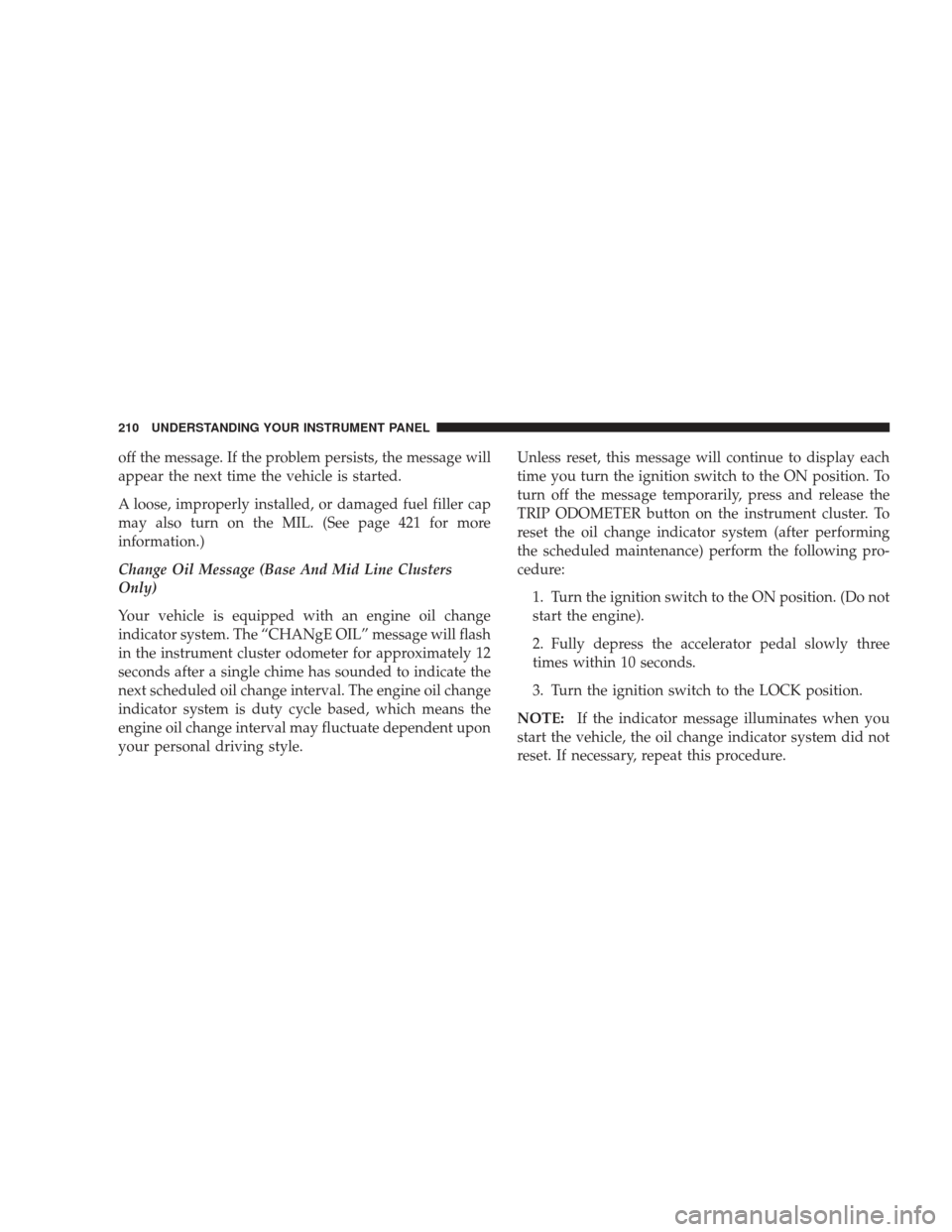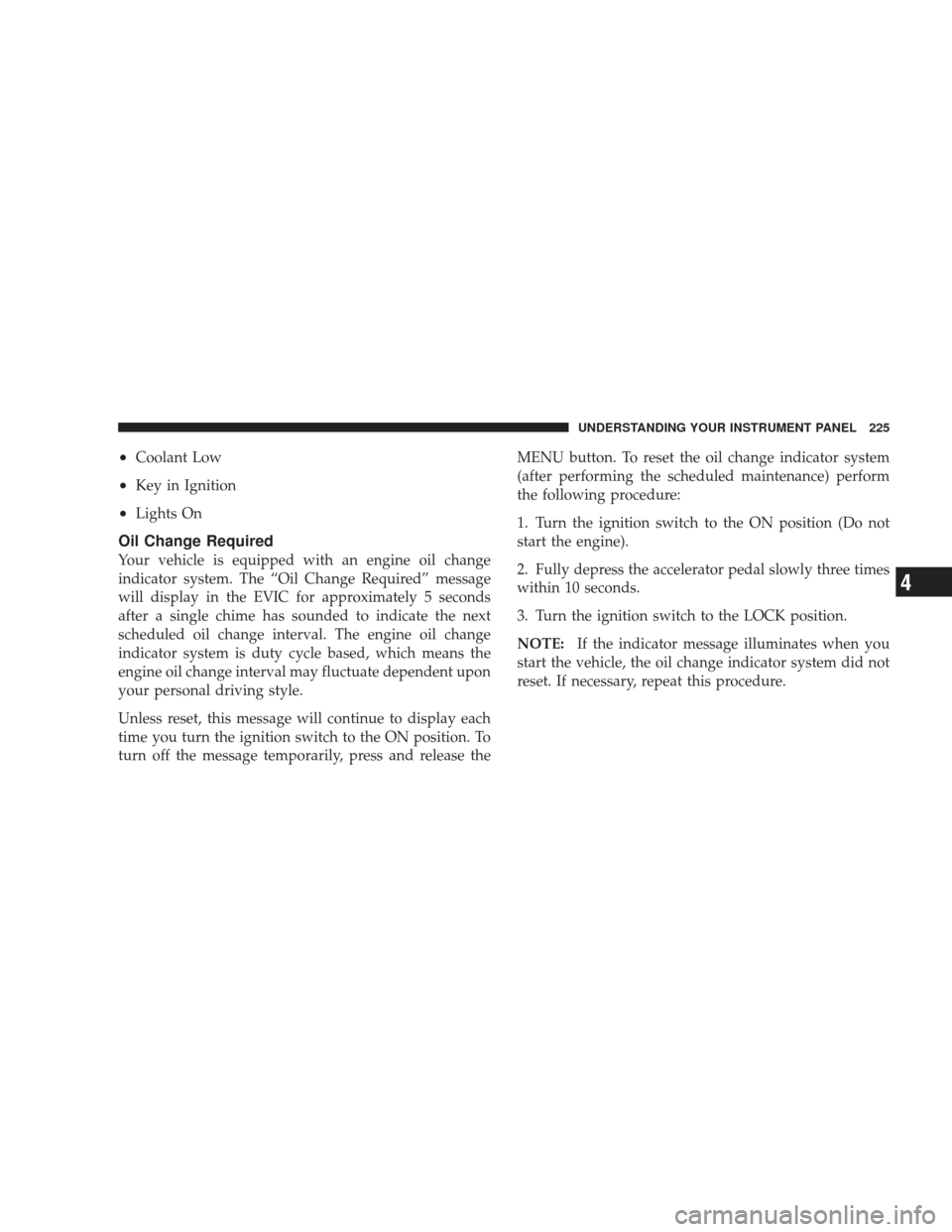Page 212 of 523

off the message. If the problem persists, the message will
appear the next time the vehicle is started.
A loose, improperly installed, or damaged fuel filler cap
may also turn on the MIL. (See page 421 for more
information.)
Change Oil Message (Base And Mid Line Clusters
Only)
Your vehicle is equipped with an engine oil change
indicator system. The “CHANgE OIL” message will flash
in the instrument cluster odometer for approximately 12
seconds after a single chime has sounded to indicate the
next scheduled oil change interval. The engine oil change
indicator system is duty cycle based, which means the
engine oil change interval may fluctuate dependent upon
your personal driving style.Unless reset, this message will continue to display each
time you turn the ignition switch to the ON position. To
turn off the message temporarily, press and release the
TRIP ODOMETER button on the instrument cluster. To
reset the oil change indicator system (after performing
the scheduled maintenance) perform the following pro-
cedure:
1. Turn the ignition switch to the ON position. (Do not
start the engine).
2. Fully depress the accelerator pedal slowly three
times within 10 seconds.
3. Turn the ignition switch to the LOCK position.
NOTE: If the indicator message illuminates when you
start the vehicle, the oil change indicator system did not
reset. If necessary, repeat this procedure.
210 UNDERSTANDING YOUR INSTRUMENT PANEL
Page 213 of 523

16. Electronic Throttle Control (ETC) Warning Light —
If EquippedThis light will turn on briefly as a bulb check
when the ignition switch is turned ON. This
light will also turn on while the engine is
running if there is a problem with the Elec-
tronic Throttle Control (ETC) system.
If the light turns on while the engine is running, safely
bring the vehicle to a complete stop as soon as possible,
place the shift lever in PARK, and cycle the ignition key.
The light should turn off. If the light remains lit with the
engine running, your vehicle will usually be drivable.
However, see your authorized dealer for service as soon
as possible.
If the light is flashing when the engine is running,
immediate service is required. In this case, you may
experience reduced performance, an elevated/rough idle
or engine stall, and your vehicle may require towing. Also, have the system checked by an authorized dealer if
the light does not turn on during starting.
17. Oil Pressure Warning Light
This light shows low engine oil pressure. The light
will turn on and remain on when the ignition
switch is turned from the LOCK or ACC position to the
ON position. The light will turn off after the engine is
started.
If the light does not turn on during starting, have the
system checked by an authorized dealer.
If the light turns on and remains on while driving, safely
bring the vehicle to a stop and shut off the engine. DO
NOT OPERATE THE VEHICLE UNTIL THE CAUSE IS
CORRECTED. This light does not show the quantity of
oil in the engine. The engine oil level must be checked
using the proper procedure. (See page 424 for more
information.)
UNDERSTANDING YOUR INSTRUMENT PANEL 211
4
Page 217 of 523

22. Anti-Lock Brake System (ABS) Warning LightThis light monitors the Anti-Lock Brake System
(ABS). The light will turn on when the ignition
switch is turned to the ON position and may
stay on for as long as four seconds.
If the ABS light remains on or turns on while driving, it
indicates that the Anti-Lock portion of the brake system
is not functioning and that service is required. However,
the conventional brake system will continue to operate
normally if the Brake System Warning Light is not on.
If the ABS light is on, the brake system should be serviced
as soon as possible to restore the benefit of Anti-Lock
brakes. Furthermore, the ABS light should be checked
frequently to assure that it is operating properly. If the
light does not turn on, have the system checked by an
authorized dealer. (See page 328 for more information.) 23. Electronic Stability Program (ESP)/Traction
Control System (TCS) Indicator Light
If this indicator light flashes during accelera-
tion, ease up on the accelerator and apply as
little throttle as possible. Adapt your speed and
driving to the prevailing road conditions. (See
page 328 for more information.)
24. Malfunction Indicator Light (MIL) This light is part of an Onboard Diagnostic
system called OBD II. The OBD system monitors
emissions, engine, and automatic transaxle con-
trol systems. The MIL will turn on when the key is in the
ON position before engine start. If the MIL does not turn
on when turning the key from LOCK or ACC to ON, have
the condition checked promptly.
Certain conditions such as a loose or missing gas cap,
poor fuel quality, etc., may illuminate the MIL after
engine start. The vehicle should be serviced if the MIL
UNDERSTANDING YOUR INSTRUMENT PANEL 215
4
Page 218 of 523

stays on through several of your typical driving cycles. In
most situations, the vehicle will drive normally and will
not require towing.
If the MIL flashes when the engine is running, serious
conditions may exist that could lead to immediate loss of
power or severe catalytic converter damage. (See page
421 for more information.)
CAUTION!
Prolonged driving with the MIL on could cause
further damage to the emissions control system. It
could also affect fuel economy and driveability. The
vehicle must be serviced before any emissions tests
can be performed.
If the MIL is flashing while the engine is running,
severe catalytic converter damage and power loss
will soon occur. Immediate service is required.25. Electronic Stability Program (ESP)/Brake Assist
System (BAS) Malfunction Indicator Light – If
Equipped
The yellow ESP/BAS Malfunction Indicator
Light will turn on when the ignition switch is
turned to the ON position. The light should go
out with the engine running. The system will
turn the light on continuously while the engine is run-
ning if it detects a malfunction in either the ESP or the
BAS or both. If this light remains on after the several
ignition cycles, and the vehicle has been driven several
miles (kilometers) at speeds greater than 30 mph (48
km/h), see your authorized dealer as soon as possible to
have the problem diagnosed and corrected. (See page 328
for more information.)
216 UNDERSTANDING YOUR INSTRUMENT PANEL
Page 222 of 523
NOTE:The default variance setting is Zone 8. When
setting the variance, the numbering will wrap around
from Zone 15 to Zone 1.
Calibrating the Compass (Mid Line Cluster Only)
If the compass appears erratic, inaccurate, or abnormal,
you may wish to calibrate it. However, prior to calibrat-
ing the compass, make sure the proper Compass Variance
value is selected.
NOTE: The shift lever must be in PARK to enter the
Calibration mode.
To calibrate the compass, first, start the engine. Next,
press and hold the COMPASS/TEMPERATURE DIS-
PLAY button until the current variance zone number
displays (approximately 10 seconds). Then, press and
hold the button again until the direction displays with
the “CAL” indicator on continuously (approximately 10
220 UNDERSTANDING YOUR INSTRUMENT PANEL
Page 227 of 523

•Coolant Low
•Key in Ignition
•Lights On
Oil Change Required
Your vehicle is equipped with an engine oil change
indicator system. The “Oil Change Required” message
will display in the EVIC for approximately 5 seconds
after a single chime has sounded to indicate the next
scheduled oil change interval. The engine oil change
indicator system is duty cycle based, which means the
engine oil change interval may fluctuate dependent upon
your personal driving style.
Unless reset, this message will continue to display each
time you turn the ignition switch to the ON position. To
turn off the message temporarily, press and release theMENU button. To reset the oil change indicator system
(after performing the scheduled maintenance) perform
the following procedure:
1. Turn the ignition switch to the ON position (Do not
start the engine).
2. Fully depress the accelerator pedal slowly three times
within 10 seconds.
3. Turn the ignition switch to the LOCK position.
NOTE:
If the indicator message illuminates when you
start the vehicle, the oil change indicator system did not
reset. If necessary, repeat this procedure.
UNDERSTANDING YOUR INSTRUMENT PANEL 225
4
Page 255 of 523

Operating Instructions — Voice Recognition
System (VR) (If Equipped)
For the radio, refer to “Voice Recognition System (VR)” in
Section 3.
For UConnect�“Voice Recognition System (VR),” refer to
“Hands-Free Communication (UConnect�)” in Section 3.
Operating Instructions - Hands-Free Phone
(UConnect�) (If Equipped)
Refer to “Hands-Free Communication (UConnect�)” in
Section 3.
Operating Instructions - Satellite Radio Mode (If
Equipped)
Refer to “Satellite Radio” in this section.
Operating Instructions - Video Entertainment
System (VES)™ (If Equipped)
Refer to separate “Video Entertainment System (VES)™
Guide.” Dolby�
Manufactured under license from Dolby�
Laboratories.
�Dolby�� and the double-D symbol are trademarks of
Dolby� Laboratories.
Macrovision
This product incorporates copyright protection technol-
ogy that is protected by U.S. patents and other intellec-
tual property rights. Use of this copyright protection
technology must be authorized by Macrovision, and is
intended for home and other limited viewing uses only,
unless otherwise authorized by Macrovision. Reverse
engineering or disassembly is prohibited
DTS™
�DTS™� and�DTS™ 2.0� are trademarks of Digital The-
ater Systems, Inc.
UNDERSTANDING YOUR INSTRUMENT PANEL 253
4
Page 287 of 523

CLIMATE CONTROLS
The air conditioning and heating system is designed to
make you comfortable in all types of weather. For infor-
mation about basic climate control functions, refer to
“General Climate Control Functions — All Systems.” For
more detailed information about the climate controls in
your vehicle, refer to “Single-Zone Manual Air Condi-
tioning and Heating System,” “Two- and Three-Zone
Manual Air Conditioning and Heating Systems,” or
“Two- and Three-Zone Automatic Temperature Control
(ATC) Systems.”
General Climate Control Functions — All Systems
Blower Control
Use this control to regulate the amount of air forced
through the ventilation system in any mode.
Temperature Control
Use this control to regulate the temperature of the air
inside the cabin.
Air Conditioning (A/C) Control
Use this control to engage and disengage the A/C.
NOTE:
•The A/C compressor will not engage until the engine
has been running for about 10 seconds.
•If A/C performance seems lower than expected, check
the front of the A/C condenser (located in front of the
radiator) for an accumulation of dirt or insects. Clean
with a gentle water spray from behind the radiator
and through the condenser. Fabric front fascia protec-
tors may reduce airflow to the condenser, reducing air
conditioning performance.
Mode Control (Air Direction)
Use these controls to choose from several patterns of air
distribution.
UNDERSTANDING YOUR INSTRUMENT PANEL 285
4